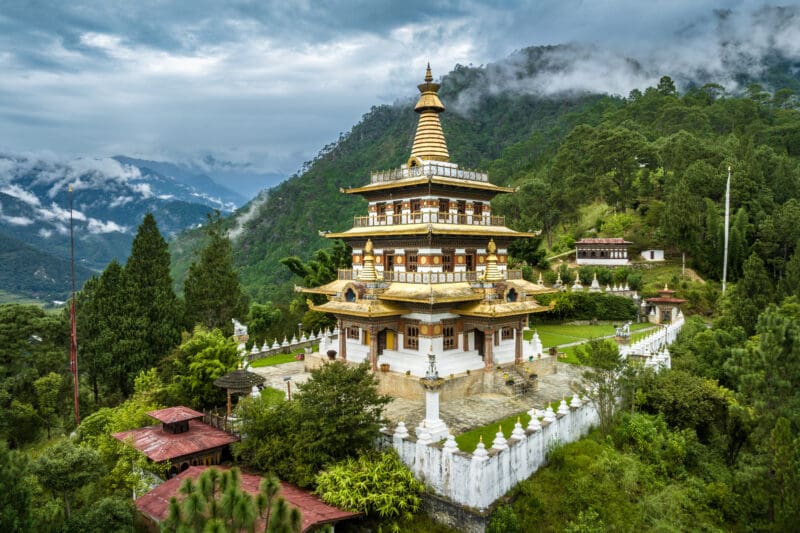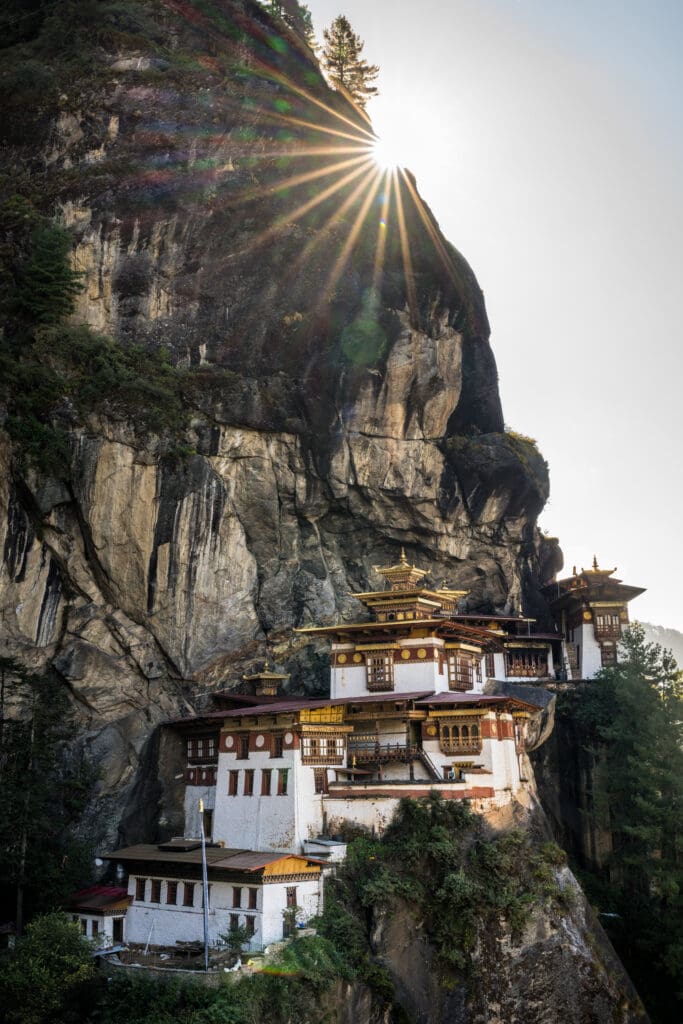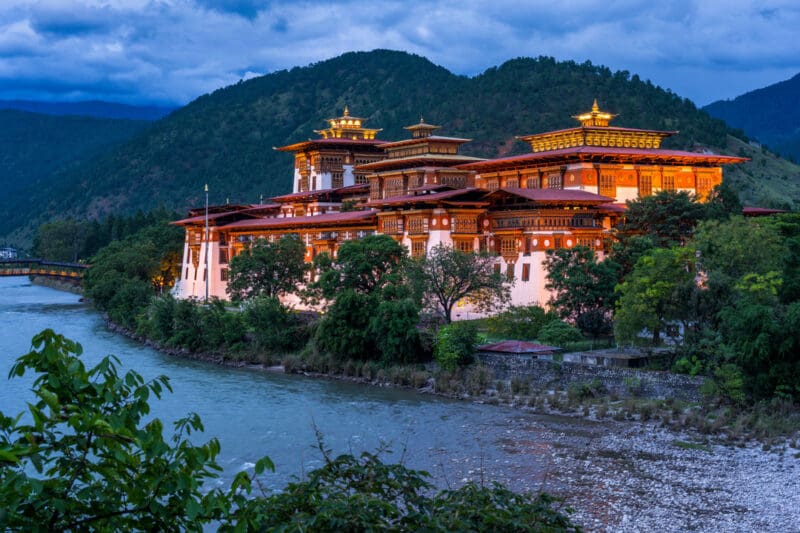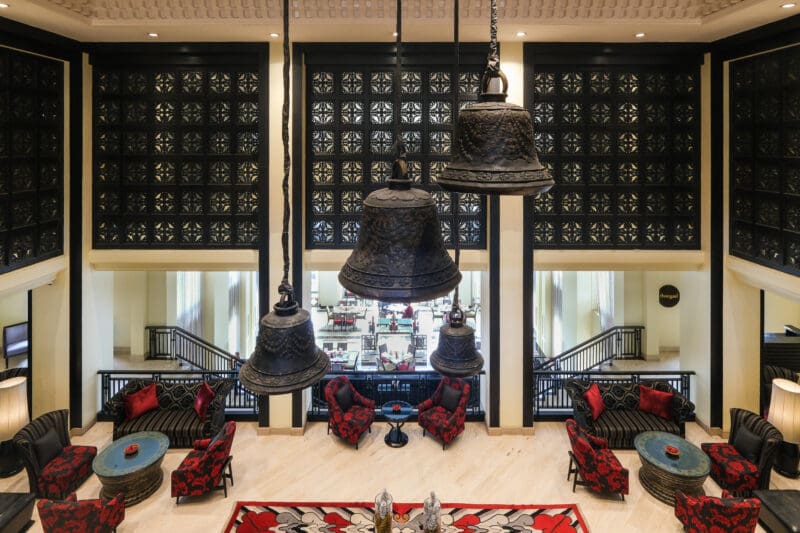WE ARE standing atop Taktsang – better known as Tiger’s Nest Monastery – Bhutan’s cliff-clinging icon at 10,000 feet above sea level. Our steep three-hour trek up the pine-forested mountain was gruelling, even with our obligatory stop at the famous “halfway” café.
According to legend, the monastery was founded in the eighth century by Padmasambhava, the “Second Buddha”, who flew to this site on the back of a tigress and meditated here for three years, three months, three weeks, three days and three hours.
This hike was the culmination of our Bhutanese adventure, having landed at Paro Airport a week earlier, with our plane banking left and right between the surrounding 18,000-foot peaks of Mount Jumolhari. Our pilot is one of only 24 in the world trained to land here.

Khamsum Yulley Namgyal Chorten | Photography bay Marcus Westberg
We have come to explore the Himalayan Kingdom of Bhutan, nestled between China and India, with a population of only 750,000 living in the valleys of a country that is 99 per cent mountainous. Buddhism, the official state religion, permeates every aspect of the Bhutanese lifestyle, culture and even attire, with men wearing the traditional Bhutanese gho and women wearing the kira.
Bhutan has undergone a remarkable transformation over the last 15 years, evolving from an absolute to a democratic monarchy, with the government monitoring the country’s prosperity through its “Gross National Happiness” index. The so-called GNH tracks the population’s mental well-being, education, cultural diversity, community spirit, sustainability and living standards.

Tiger’s Nest Monastery | Photography bay Marcus Westberg
On our one-hour drive from the airport to the capital, Thimphu, our guide explains the reason for the mandatory accompaniment of all international tourists. It’s to ensure reverence for Bhutanese religious sites, to show respect for national traditions and to protect the environment.
We check in at Pemako Thimphu, a striking hotel enveloped by the vista of the surrounding mountains. Its exterior features a traditional Bhutanese façade with whitewashed walls, intricate wooden cornices and lotus-shaped window frames. The resident Buddhist monk blesses us with a welcoming ceremony, tying a red thread around our wrists, symbolising good luck and prosperity, which we proudly wear for the duration of our trip.

Punakha Dzong | Photography bay Marcus Westberg
We are perfectly located to explore this quaint city and viewing its distinctive architecture, with each building adorned with ornate colourful designs and religious symbols. We later discover that the Bhutanese style of architecture extends to all the country’s monuments, dzongs, temples and monasteries.
Thimphu is the place to purchase textiles and handicrafts, to indulge in Bhutanese cuisine and to mingle with the locals. We admire the theatrical moves of the white gloved traffic policeman in an impeccable uniform, standing in his signal box directing traffic at the city’s only roundabout. Intriguingly, there are no traffic lights anywhere in Bhutan.

Pemako Thimphu Lobby and Restaurant
A two-hour drive eastward across never-ending undulating valleys and verdant mountain peaks takes us to Punakha, the ancient capital city. We are staying at Como Uma Punakha, where our balcony overlooks the breadth of the riverine Punakha Valley. In the morning, we follow a trail to hike up to Khamsum Yulley Namgyal Chorten, a modern monastery built in 2004 to ward off evil spirits and bring peace and harmony to all living things. Afterwards, we take a river raft to Punakha Dzong, a fortress monastery and one of Bhutan’s most revered sites.
After our descent from Tiger’s Nest near Paro, we head to our hotel, Amankora Paro, and its sultry Aman spa with its specially blended Aman amenities. We luxuriate in a traditional steamy hot stone bath, infused with rosemary, to ease our weary muscles. This pristine lodge, with its minimal aesthetic and incomparable service, offers unrestricted mealtimes serving Michelin-star worthy dishes, a help-yourself bar, daily cultural activities and a same-day laundry service.
We came to explore what makes this tiny Kingdom of Bhutan the happiest place on earth. We depart feeling privileged to have experienced the uniqueness of Bhutan’s traditional lifestyle and the sense the excitement for the King of Bhutan’s plan for the economic development of Gelephu in the more accessible south of the country, which will enable many more tourists to experience this happy Himalayan Kingdom in the near future.
by Amanda Bernstein
COMO Uma Punakha: Valley room stays start from $695 per night, inclusive of tax and service charge. COMO offers end to end services including visa applications, guides and activities.
Pemako Thimphu: stays start from $1,020 during high season (March-May/September- November). Rates include accommodation on a B&B basis and use of hotel amenities.
Stays at Amankora start from $1,900 per night, based on double occupancy, excluding taxes and fees, all meals at Amankora Dining Room, picnics en route to other Amankora lodges, in-house beverages.
For more information on visiting Bhutan, see bhutan.travel
